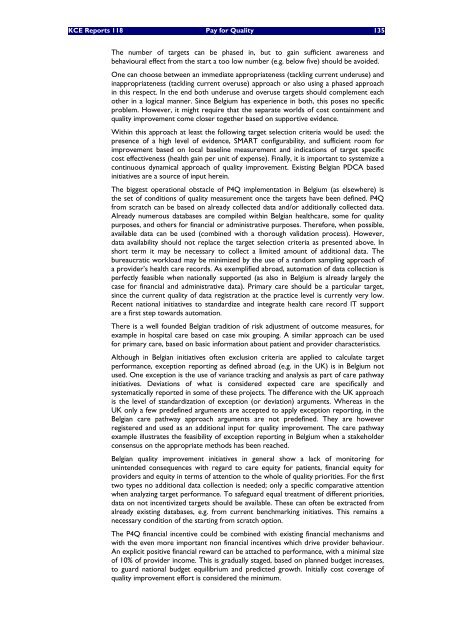Pay for Quality
Pay for Quality
Pay for Quality
Create successful ePaper yourself
Turn your PDF publications into a flip-book with our unique Google optimized e-Paper software.
KCE Reports 118 <strong>Pay</strong> <strong>for</strong> <strong>Quality</strong> 135<br />
The number of targets can be phased in, but to gain sufficient awareness and<br />
behavioural effect from the start a too low number (e.g. below five) should be avoided.<br />
One can choose between an immediate appropriateness (tackling current underuse) and<br />
inappropriateness (tackling current overuse) approach or also using a phased approach<br />
in this respect. In the end both underuse and overuse targets should complement each<br />
other in a logical manner. Since Belgium has experience in both, this poses no specific<br />
problem. However, it might require that the separate worlds of cost containment and<br />
quality improvement come closer together based on supportive evidence.<br />
Within this approach at least the following target selection criteria would be used: the<br />
presence of a high level of evidence, SMART configurability, and sufficient room <strong>for</strong><br />
improvement based on local baseline measurement and indications of target specific<br />
cost effectiveness (health gain per unit of expense). Finally, it is important to systemize a<br />
continuous dynamical approach of quality improvement. Existing Belgian PDCA based<br />
initiatives are a source of input herein.<br />
The biggest operational obstacle of P4Q implementation in Belgium (as elsewhere) is<br />
the set of conditions of quality measurement once the targets have been defined. P4Q<br />
from scratch can be based on already collected data and/or additionally collected data.<br />
Already numerous databases are compiled within Belgian healthcare, some <strong>for</strong> quality<br />
purposes, and others <strong>for</strong> financial or administrative purposes. There<strong>for</strong>e, when possible,<br />
available data can be used (combined with a thorough validation process). However,<br />
data availability should not replace the target selection criteria as presented above. In<br />
short term it may be necessary to collect a limited amount of additional data. The<br />
bureaucratic workload may be minimized by the use of a random sampling approach of<br />
a provider’s health care records. As exemplified abroad, automation of data collection is<br />
perfectly feasible when nationally supported (as also in Belgium is already largely the<br />
case <strong>for</strong> financial and administrative data). Primary care should be a particular target,<br />
since the current quality of data registration at the practice level is currently very low.<br />
Recent national initiatives to standardize and integrate health care record IT support<br />
are a first step towards automation.<br />
There is a well founded Belgian tradition of risk adjustment of outcome measures, <strong>for</strong><br />
example in hospital care based on case mix grouping. A similar approach can be used<br />
<strong>for</strong> primary care, based on basic in<strong>for</strong>mation about patient and provider characteristics.<br />
Although in Belgian initiatives often exclusion criteria are applied to calculate target<br />
per<strong>for</strong>mance, exception reporting as defined abroad (e.g. in the UK) is in Belgium not<br />
used. One exception is the use of variance tracking and analysis as part of care pathway<br />
initiatives. Deviations of what is considered expected care are specifically and<br />
systematically reported in some of these projects. The difference with the UK approach<br />
is the level of standardization of exception (or deviation) arguments. Whereas in the<br />
UK only a few predefined arguments are accepted to apply exception reporting, in the<br />
Belgian care pathway approach arguments are not predefined. They are however<br />
registered and used as an additional input <strong>for</strong> quality improvement. The care pathway<br />
example illustrates the feasibility of exception reporting in Belgium when a stakeholder<br />
consensus on the appropriate methods has been reached.<br />
Belgian quality improvement initiatives in general show a lack of monitoring <strong>for</strong><br />
unintended consequences with regard to care equity <strong>for</strong> patients, financial equity <strong>for</strong><br />
providers and equity in terms of attention to the whole of quality priorities. For the first<br />
two types no additional data collection is needed; only a specific comparative attention<br />
when analyzing target per<strong>for</strong>mance. To safeguard equal treatment of different priorities,<br />
data on not incentivized targets should be available. These can often be extracted from<br />
already existing databases, e.g. from current benchmarking initiatives. This remains a<br />
necessary condition of the starting from scratch option.<br />
The P4Q financial incentive could be combined with existing financial mechanisms and<br />
with the even more important non financial incentives which drive provider behaviour.<br />
An explicit positive financial reward can be attached to per<strong>for</strong>mance, with a minimal size<br />
of 10% of provider income. This is gradually staged, based on planned budget increases,<br />
to guard national budget equilibrium and predicted growth. Initially cost coverage of<br />
quality improvement ef<strong>for</strong>t is considered the minimum.
















